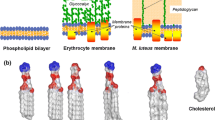Abstract
The effect of acyl chain structure and bilayer phase state on binding and penetration by the peptide HPA3 was studied using dual polarisation interferometry. This peptide is an analogue of Hp(2-20) derived from the N-terminus of Helicobacter pylori ribosomal protein L1 (RpL1) which has been shown to have antimicrobial and cell-penetrating properties. The binding of HPA3 to zwitterionic 1,2-dimyristoyl-sn-glycero-3-phosphocholine (DMPC) or 1-palmitolyl-2-oleyl-sn-glycero-3-phosphocholine (POPC) and negatively charged membranes composed of DMPC and 1,2-dimyristoyl-sn-glycero-3-(phosphor-rac-(1-glycerol)) (DMPG) or POPC and 1-palmitolyl-2-oleyl-sn-glycero-3-(phosphor-rac-(1-glycerol)) (POPG) was determined using dual polarisation interferometry (DPI). Mass and birefringence were measured in real time, enabling the creation of birefringence–mass plots for detailed analysis of the changes in lipid bilayer order during the peptide-binding process. HPA3 bound to all four lipids and the binding progressed as a single phase for the saturated gel phase bilayers DMPC and DMPC–DMPG. However, the binding process involved two or more phases, with penetration of the unsaturated fluid phase POPC and POPC–POPG bilayers. Structural changes in the saturated bilayer were partially reversible whereas binding to the unsaturated bilayer resulted in irreversible changes in membrane structure. These results demonstrate that more disordered unsaturated bilayers are more susceptible to further disorganisation and have a lower capacity to recover from peptide-induced structural changes than saturated ordered bilayers. In addition, this study further establishes DPI as powerful tool for analysis of multiphase peptide-insertion processes associated with complex structural changes in the liquid-crystalline membrane.





Similar content being viewed by others
References
Benes M, Billy D, Benda A, Speijer H, Hof M, Hermens WT (2004) Surface-dependent transitions during self-assembly of phospholipid membranes on mica, silica, and glass. Langmuir 20:10129–10137
Chen YH, Yang JT, Chau KH (1974) Determination of the helix and beta form of proteins in aqueous solution by circular dichroism. Biochemistry 13:3350–3359
Feijter F de, Benjamins J, Veer F (1978) Ellipsometry as a tool to study the adsorption behaviour of synthetic and biopolymers at the air-water interface. Biopolymers 17:1759–1772
Gehman JD, Luc F, Hall K, Lee TH, Boland MP, Pukala TL, Bowie JH, Aguilar MI, Separovic F (2008) Effect of antimicrobial peptides from Australian tree frogs on anionic phospholipid membranes. Biochemistry 47:8557–8565
Hall K, Mozsolits H, Aguilar M (2003) Surface plasmon resonance analysis of antimicrobial peptide-membrane interactions: affinity and mechanism of action. Lett Peptide Sci 10:475–485
Horvath R, Ramsden J (2007) Quasi-isotropic analysis of anisotropic thin films on optical waveguides. Langmuir 23:9330–9334
Jin Y, Mozsolits H, Hammer J, Zmuda E, Zhu F, Zhang Y, Aguilar MI, Blazyk J (2003) Influence of tryptophan on lipid binding of linear amphipathic cationic antimicrobial peptides. Biochemistry 42:9395–9405
Lee KH, Lee DG, Park Y, Kang DI, Shin SY, Hahm KS, Kim Y (2006) Interactions between the plasma membrane and the antimicrobial peptide HP (2-20) and its analogues derived from Helicobacter pylori. Biochem J 394:105–114
Lee T, Hall K, Swann M, Popplewell J, Unabia S, Park Y, Hahm K, Aguilar M (2010a) The membrane insertion of helical antimicrobial peptides from the N-terminus of Helicobacter pylori ribosomal protein L1. Biochim Biophys Acta 1798:544–557
Lee TH, Heng C, Swann MJ, Gehman JD, Separovic F, Aguilar MI (2010b) Real-time quantitative analysis of lipid disordering by aurein 1.2 during membrane adsorption, destabilisation and lysis. Biochim Biophys Acta 1798:1977–1986
Mashaghi A, Swann M, Textor JPM, Reimhult E (2008) Optical anisotropy of supported lipid structures probed by waveguide spectroscopy and its application to study of supported lipid bilayer formation kinetics. Anal Chem 80:3666–3676
Melo MN, Ferre R, Castanho MA (2009) Antimicrobial peptides: linking partition, activity and high membrane-bound concentrations. Nat Rev Microbiol 7:245–250
Mereuta L, Luchian T, Park Y, Hahm K (2009) The role played by lipids unsaturation upon the membrane interaction of the Helicobacter pylori HP(2-20) antimicrobial peptide analogue HPA3. J Bioenerg Biomembr 41:79–84
Mozsolits H, Aguilar MI (2002) Surface plasmon resonance spectroscopy: an emerging tool for the study of peptide-membrane interactions. Biopolymers 66:3–18
Mozsolits H, Wirth HJ, Werkmeister J, Aguilar MI (2001) Analysis of antimicrobial peptide interactions with hybrid bilayer membrane systems using surface plasmon resonance. Biochim Biophys Acta 1512:64–76
Papo N, Shai Y (2003) Exploring peptide membrane interaction using surface plasmon resonance: differentiation between pore formation versus membrane disruption by lytic peptides. Biochemistry 42:458–466
Park S, Kim M, Hossain M, Shin S, Kim Y, Stella L, Wade J, Park Y, Hahm K (2008) Amphipathic alpha-helical peptide, HP (2-20), and its analogues derived from Helicobacter pylori: pore formation mechanism in various lipid compositions. Biochim Biophys Acta 1778:229–241
Popplewell JF, Swann MJ, Freeman NJ, McDonnell C, Ford RC (2007) Quantifying the effects of melittin on liposomes. Biochim Biophys Acta 1768:13–20
Shai Y (2002) Mode of action of membrane active antimicrobial peptides. Biopolymers 66:236–248
Swann MJ, Peel LL, Carrington S, Freeman NJ (2004) Dual-polarization interferometry: an analytical technique to measure changes in protein structure in real time, to determine the stoichiometry of binding events, and to differentiate between specific and nonspecific interactions. Anal Biochem 329:190–198
Yu L, Guo L, Ding JL, Ho B, Feng SS, Popplewell J, Swann M, Wohland T (2009) Interaction of an artificial antimicrobial peptide with lipid membranes. Biochim Biophys Acta 1788:333–344
Zasloff M (2002) Antimicrobial peptides of multicellular organisms. Nature 415:389–395
Zwang TJ, Fletcher WR, Lane TJ, Johal MS (2010) Quantification of the layer of hydration of a supported lipid bilayer. Langmuir 26:4598–4601
Acknowledgments
We would like to thank the Faculty of Medicine Nursing & Health Sciences, Monash University and ATA Scientific for seed funding. The financial support of the Australian Research Council, the Potter Foundation and the European Union Framework 7 project ASMENA is also gratefully acknowledged.
Author information
Authors and Affiliations
Corresponding author
Additional information
Membrane-active peptides: 455th WE-Heraeus-Seminar and AMP 2010 Workshop.
Electronic supplementary material
Below is the link to the electronic supplementary material.
Rights and permissions
About this article
Cite this article
Hirst, D.J., Lee, TH., Swann, M.J. et al. Effect of acyl chain structure and bilayer phase state on binding and penetration of a supported lipid bilayer by HPA3. Eur Biophys J 40, 503–514 (2011). https://doi.org/10.1007/s00249-010-0664-1
Received:
Accepted:
Published:
Issue Date:
DOI: https://doi.org/10.1007/s00249-010-0664-1




